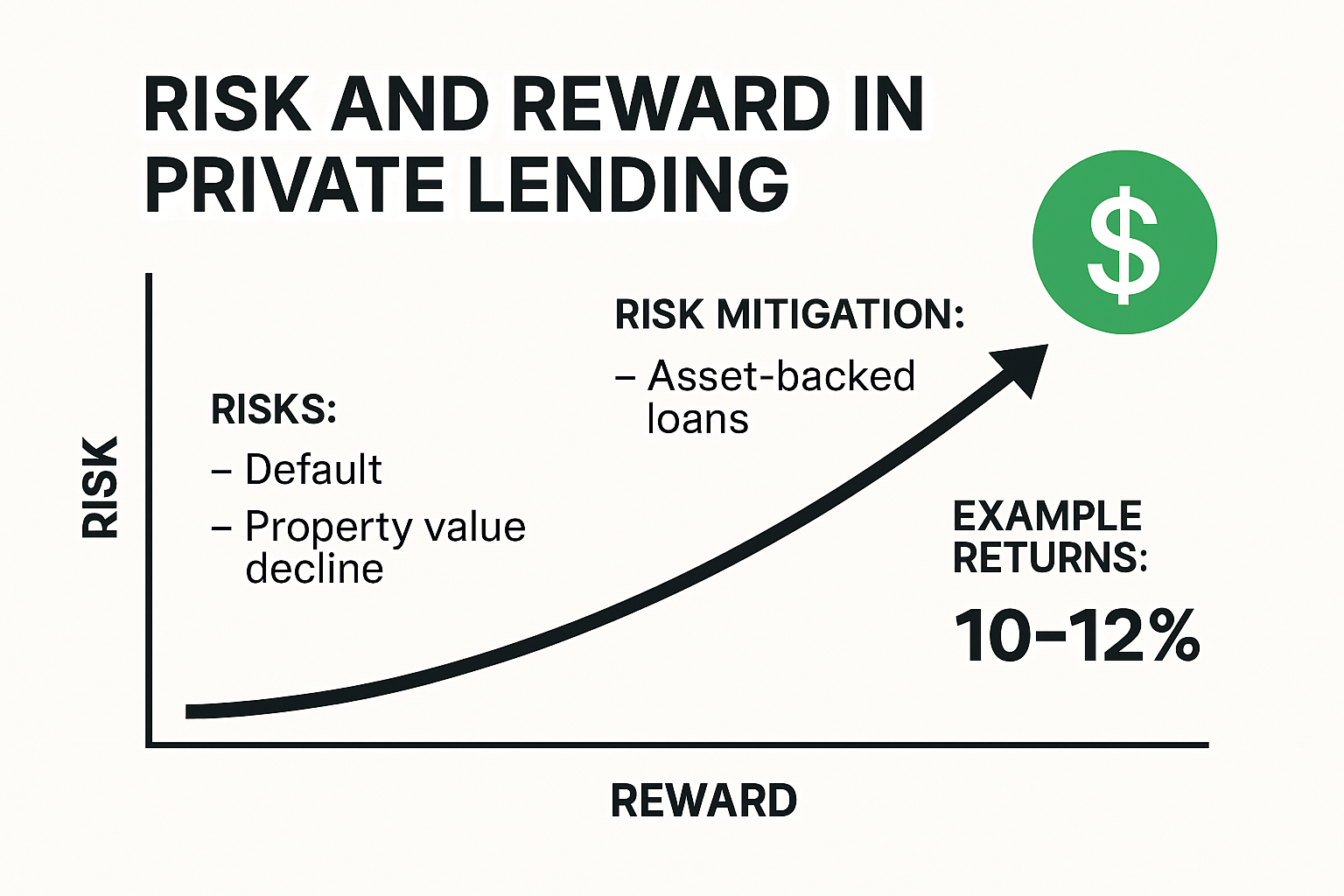
Private lending has become a hot topic for investors chasing bigger yields and greater control in 2025. Most people are stunned to learn that private credit investments can generate returns between 8% and 18% per year, far outpacing most traditional savings or bonds. Still, while everyone talks about the high profits, the real surprise is how modern technology and detailed legal protections can make private lending dramatically safer than many assume. Instead of rushing in for quick gains, the savviest investors are now using new tools and smarter strategies to turn what looks risky on the surface into a carefully engineered source of passive income.
Table of Contents
- Understanding Private Lending Risks And Rewards
- The Risk Profile Of Private Credit Investments
- Evaluating Potential Rewards In Private Lending
- Mitigation Strategies For Private Lending Risks
- How Safety Works In Private Lending Deals
- Legal Frameworks And Structural Protections
- Collateral Verification And Risk Assessment
- Technology And Due Diligence Processes
- Tips For Secure Private Lending In Costa Rica
- Legal And Regulatory Foundations
- Collateral And Risk Mitigation Strategies
- Technology And Local Expertise
- Who Should Consider Private Lending In 2025
- Investor Financial Profiles
- Risk Tolerance And Investment Sophistication
- Target Investor Categories
Quick Summary
| Takeaway | Explanation |
|---|---|
| Understand the Risk Spectrum | Private lending ranges from conservative secured loans to high-risk unsecured lending, requiring rigorous due diligence on borrower creditworthiness and collateral quality. |
| Implement Effective Risk Mitigation | Successful investors utilize strategies like thorough background checks, maintaining diversified portfolios, and establishing strong legal protections to manage potential risks. |
| Leverage Technology and Local Expertise | Utilizing advanced screening tools and cultivating relationships with local professionals is essential for navigating private lending safely, particularly in markets like Costa Rica. |
| Identify Suitable Investor Profiles | Ideal participants in private lending are often high net worth individuals or experienced investment professionals who possess a resilient financial understanding and a sophisticated approach to risk management. |
| Focus on Legal and Regulatory Compliance | Ensuring adherence to local laws and regulations, especially in international markets, is critical for safeguarding investments in private lending. |
Understanding Private Lending Risks and Rewards
Private lending represents a complex financial landscape where potential rewards must be carefully balanced against potential risks. Investors considering this investment strategy need a comprehensive understanding of how private lending operates and what factors can impact their financial outcomes.

The Risk Profile of Private Credit Investments
Private lending is not a one size fits all investment approach. The risk spectrum ranges from relatively conservative secured loans to high risk unsecured lending opportunities. Sophisticated investors recognize that while private lending can offer attractive returns typically between 8% to 18% annually, these potential gains come with substantial risk exposure.
The fundamental risk in private lending stems from borrower default potential. Unlike traditional bank loans, private lending often involves less stringent qualification criteria, which means investors must conduct rigorous due diligence. This includes comprehensive background checks, verifying income sources, assessing collateral value, and understanding the borrower’s overall financial health.
Critical risk factors include:
- Borrower Creditworthiness: Direct correlation between borrower financial stability and loan repayment probability
- Collateral Quality: The underlying asset’s market value and liquidity
- Economic Conditions: Broader economic trends that might impact borrower income and asset values
Evaluating Potential Rewards in Private Lending
Successful private lending hinges on strategic risk management and thorough investment evaluation. Investors who explore comprehensive lending strategies can potentially generate consistent passive income streams with higher returns compared to traditional fixed income investments.
Rewards in private lending emerge through multiple channels. Interest rates are typically higher than conventional bank loan rates, reflecting the increased risk and reduced regulatory oversight. Experienced investors often structure loans with additional protections such as first lien positions, personal guarantees, and cross collateralization to mitigate potential losses.
Key reward considerations include:
- Higher Interest Rates: Potential returns ranging from 12% to 18% annually
- Portfolio Diversification: Alternative investment opportunity uncorrelated with stock market performance
- Flexible Investment Structures: Ability to customize loan terms and conditions
Below is a summary table highlighting the key risk factors and reward considerations in private lending to help readers easily compare what drives both aspects of this investment approach.
| Aspect | Key Factors / Considerations | Impact on Investment |
|---|---|---|
| Borrower Creditworthiness | Financial health, default risk | Higher risk if poor, safer if strong |
| Collateral Quality | Market value, liquidity, verification | Improves safety, recoup losses |
| Economic Conditions | Market trends, asset value fluctuation | Can affect repayment and asset value |
| Interest Rates | 8% to 18% typical range | Higher rewards, but with risk |
| Diversification | Loan mix, asset diversity | Reduces overall investment risk |
| Custom Structures | Loan terms, legal protections | Enhances control and security |
Mitigation Strategies for Private Lending Risks
Risk management is paramount in private lending. Successful investors implement multi layered strategies to protect their capital. This involves comprehensive borrower screening, maintaining diversified loan portfolios, establishing clear legal frameworks, and continuously monitoring investment performance.
Effective risk mitigation techniques include:
- Conducting thorough borrower background investigations
- Requiring substantial collateral with verifiable market value
- Implementing strict loan to value ratios
- Developing robust legal documentation
- Maintaining financial reserves for potential defaults
Private lending demands a sophisticated approach. While potential rewards can be attractive, investors must remain vigilant, conduct extensive research, and maintain a disciplined investment strategy. Understanding the intricate balance between risk and reward is crucial for long term success in this dynamic financial arena.
How Safety Works in Private Lending Deals
Safety in private lending is not a passive concept but an active, strategic approach that requires meticulous planning, comprehensive risk assessment, and robust protective mechanisms. Investors who understand the intricate layers of safety can navigate this complex financial landscape with greater confidence and reduced potential for significant losses.
Legal Frameworks and Structural Protections
The foundation of safety in private lending rests on solid legal infrastructure. Sophisticated investors implement multi tier protection strategies that go beyond traditional lending approaches. This involves creating legally binding documents that clearly outline loan terms, borrower obligations, and specific recourse mechanisms in case of default.
Key legal protections typically include:
- First Lien Positions: Prioritizing investor claims on collateral assets
- Comprehensive Loan Agreements: Detailed contracts specifying precise repayment terms
- Personal Guarantees: Additional accountability measures from borrowers
These legal frameworks provide critical safeguards that transform private lending from a speculative activity into a structured investment strategy. Learn about advanced lending protection strategies to enhance your understanding of comprehensive risk management.
Collateral Verification and Risk Assessment
Collateral serves as the primary safety mechanism in private lending. Rigorous asset evaluation becomes paramount in determining the potential recoverability of investments. Professional investors conduct thorough property assessments, market value analyses, and detailed asset inspections to ensure the underlying security maintains sufficient value to cover potential loan defaults.
Effective collateral risk management involves:
- Professional property appraisals
- Comprehensive market value comparisons
- Ongoing asset condition monitoring
- Geographic and economic risk assessments
Investors who implement systematic verification processes significantly reduce their exposure to potential financial losses. The goal is creating a robust safety net that protects capital even under challenging economic conditions.

Technology and Due Diligence Processes
Modern private lending safety relies heavily on advanced technological tools and comprehensive due diligence processes. Sophisticated screening algorithms, credit analysis software, and robust background verification systems help investors make informed decisions.
Critical technological safety components include:
- Advanced borrower credit scoring systems
- Real time financial monitoring platforms
- Automated risk assessment algorithms
- Comprehensive documentation verification tools
To clarify how technology and legal strategies interact to improve deal safety, the following table summarizes the main protective mechanisms available to private lenders.
| Safety Mechanism | Description |
|---|---|
| First Lien Position | Lender has priority claim on collateral |
| Comprehensive Agreements | Detailed, legally binding loan documents |
| Personal Guarantees | Borrower’s additional assurance of repayment |
| Professional Collateral Appraisal | Independent property/asset valuation |
| Automated Credit Analysis | Software-driven borrower risk assessment |
| Real-Time Asset Monitoring | Ongoing digital tracking of collateral status |
| Regulatory Compliance | Adherence to relevant local laws |
These technological solutions transform private lending from a high risk endeavor into a more predictable and manageable investment strategy. By leveraging data driven insights, investors can make more informed decisions and implement proactive risk mitigation techniques.
Private lending safety is not about eliminating all risks but about understanding, managing, and strategically mitigating potential challenges. Successful investors recognize that safety emerges from a combination of legal protections, thorough asset evaluation, technological insights, and continuous monitoring. While no investment is completely risk free, a disciplined and sophisticated approach can significantly enhance the security of private lending investments.
Tips for Secure Private Lending in Costa Rica
Private lending in Costa Rica offers unique opportunities for investors, but success requires a strategic approach that balances potential returns with comprehensive risk management. Understanding the local financial landscape is crucial for creating secure and profitable lending strategies.
Legal and Regulatory Foundations
Navigating Costa Rica’s legal framework is fundamental to secure private lending. The country’s robust property laws and financial regulations provide a structured environment for investors. Foreign and local lenders must comprehensively understand the legal mechanisms that protect investment interests.
Key legal considerations include:
- Property Ownership Verification: Confirming clear title and ownership history
- Regulatory Compliance: Adhering to local financial regulations
- Notarized Documentation: Ensuring all loan agreements have legal standing
Discover comprehensive lending guidelines for Costa Rica to maximize your investment security and understanding of local requirements.
Collateral and Risk Mitigation Strategies
Real estate serves as the primary collateral mechanism in Costa Rican private lending. Sophisticated investors implement multi layered protection strategies that go beyond basic asset evaluation. This involves conducting thorough property assessments, understanding local market dynamics, and establishing clear recovery mechanisms.
Effective risk mitigation techniques include:
- Professional Property Appraisals: Obtaining independent valuations
- Loan to Value Ratio Management: Maintaining conservative lending parameters
- Geographic Risk Assessment: Evaluating location specific economic factors
Investors must conduct comprehensive due diligence that extends beyond surface level evaluations. This means verifying property titles, understanding local zoning regulations, and assessing potential environmental or legal encumbrances that could impact the underlying asset value.
Technology and Local Expertise
Successful private lending in Costa Rica demands a combination of technological tools and local market knowledge. Investors should leverage advanced screening technologies while simultaneously building relationships with local legal and real estate professionals who understand the nuanced local market dynamics.
Critical technological and expertise components include:
- Local Legal Consultations: Engaging Costa Rican legal professionals
- Advanced Borrower Screening: Utilizing comprehensive background verification systems
- Real Time Market Monitoring: Tracking local economic and property market trends
- Language and Cultural Understanding: Navigating local business communication norms
Private lending in Costa Rica is not about eliminating all risks but about developing a sophisticated, informed approach to investment. Successful investors recognize that safety emerges from a careful blend of legal protections, technological insights, local expertise, and continuous market monitoring.
While the potential for attractive returns exists, investors must remain disciplined and strategic. Thorough research, robust legal frameworks, and a deep understanding of local market conditions are the cornerstones of secure private lending in Costa Rica. By implementing these comprehensive strategies, investors can transform potential challenges into calculated investment opportunities.
Who Should Consider Private Lending in 2025
Private lending represents a sophisticated investment strategy that is not suitable for every investor. Understanding the specific profile and financial characteristics of ideal private lending participants becomes crucial in 2025’s complex financial landscape.
Investor Financial Profiles
Successful private lending participants typically possess robust financial foundations and specific investment characteristics. These investors are not casual market participants but strategic financial professionals seeking alternative investment channels with potentially higher returns.
Ideal investor profiles include:
- High Net Worth Individuals: Those with substantial liquid assets
- Experienced Investment Professionals: Individuals with complex financial understanding
- Diversification Seekers: Investors looking beyond traditional market instruments
Explore targeted lending opportunities for sophisticated investors to understand your potential fit in this investment ecosystem.
Risk Tolerance and Investment Sophistication
Private lending demands a nuanced understanding of financial risk and sophisticated investment strategies. Investors must possess emotional and financial resilience to navigate potential market uncertainties. This requires more than financial capital it demands intellectual capital and comprehensive risk management skills.
Key risk management capabilities include:
- Advanced Financial Literacy: Understanding complex investment mechanisms
- Emotional Stability: Capacity to manage potential investment volatility
- Strategic Thinking: Ability to analyze comprehensive financial scenarios
- Comprehensive Due Diligence Skills: Evaluating investment opportunities meticulously
Successful private lending investors recognize that this investment approach is not about immediate returns but strategic long term wealth building. They view investments through a holistic lens, considering broader economic trends and potential market shifts.
Target Investor Categories
Private lending in 2025 attracts specific investor categories with unique financial objectives. These investors are not homogeneous but represent diverse professional backgrounds united by sophisticated investment approaches.
Primary investor categories include:
- Expatriate Investors: Professionals seeking alternative international investment channels
- Retirement Portfolio Managers: Individuals looking for higher yield investment options
- Real Estate Investment Professionals: Those with deep understanding of property markets
- Entrepreneurial Investors: Self employed professionals seeking passive income streams
Each investor category brings unique perspectives and skills. Expatriate investors often leverage international financial knowledge. Retirement portfolio managers prioritize stable, consistent returns. Real estate professionals understand underlying asset values, while entrepreneurial investors bring dynamic risk assessment skills.
Private lending is not an entry level investment strategy. It requires a combination of financial resources, sophisticated market understanding, and strategic thinking. Investors considering this path must conduct extensive research, understand their personal risk tolerance, and develop comprehensive investment strategies.
The most successful private lending participants in 2025 will be those who approach this investment method with intellectual curiosity, rigorous analysis, and a long term wealth building perspective. They understand that private lending is not about quick gains but about creating sustainable, strategically managed investment portfolios that generate consistent returns while managing potential risks effectively.
Frequently Asked Questions
What are the risks associated with private lending?
Private lending risks include borrower default, collateral quality, and economic conditions. Investors must conduct thorough due diligence and evaluate borrower creditworthiness to mitigate these risks.
How can I ensure safety in private lending?
Safety in private lending can be enhanced by implementing robust legal frameworks, requiring substantial collateral, and utilizing technology for due diligence processes, such as background checks and real-time asset monitoring.
What returns can investors expect from private lending in 2025?
Investors in private lending can potentially earn returns ranging from 8% to 18% per year, depending on the terms of the loan and the risks involved.
Who should consider private lending as an investment strategy?
Private lending is ideal for high net worth individuals, experienced investment professionals, and those with a strong understanding of financial risks who seek higher yield investment opportunities.
Ready to Invest in Secure Private Lending Opportunities in Costa Rica?
After exploring critical safety concerns in private lending and understanding the risks of borrower default, collateral quality, and the need for transparent legal frameworks, you may be wondering how to confidently put these essential facts into practice. Many investors want to achieve high-yield, real estate-backed returns without losing sleep over unreliable loan structures or insufficient vetting. This is exactly where CostaRicaLoanExperts.net delivers peace of mind and strategic advantage.

At CostaRicaLoanExperts.net you get access to private loan opportunities tailored for 2025’s demanding investment climate. Every deal is supported by thorough due diligence and first-lien protections on prime Costa Rican properties. Explore our detailed breakdown of lending solutions to see how we address every pain point discussed in this article. Do not wait while others secure high-yield positions in this competitive market. Discover your next secure investment and start building smarter wealth with a trusted partner by visiting CostaRicaLoanExperts.net today.
Recommended
- private lending opportunities 2025 – costaricaloanexperts.net
- private lending best practices – costaricaloanexperts.net
- Private Lending Best Practices for Expats and Investors 2025 – costaricaloanexperts.net
- Private Lending Opportunities 2025: Smart Strategies for Expats & Investors – costaricaloanexperts.net
- private lending explained – costaricaloanexperts.net
- Private Lending Explained: Guide for Costa Rica Investors 2025 – costaricaloanexperts.net
